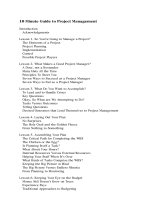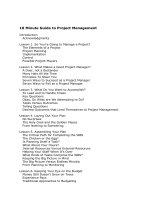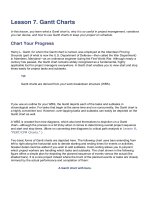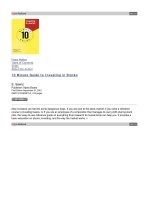10 Minute Guide to Investing in Stocks Chapter 15 pptx
Bạn đang xem bản rút gọn của tài liệu. Xem và tải ngay bản đầy đủ của tài liệu tại đây (451.67 KB, 21 trang )
I l@ve RuBoard
Lesson 15. The Ticker Tape, Stock Indices, and Other
Media
In this lesson you will learn about further sources of information on your stock's performance.
I l@ve RuBoard
I l@ve RuBoard
The Ticker Tape
No image better represents the United States stock markets than the ticker tape. The little
one-inch-wide strip of paper is as synonymous with following the performance of stocks and
their markets as it is with heroes' welcomes and parades. Ironically, you would be hard
pressed to find an actual ticker tape machine outside of a museum or, for that matter, to find
a parade that still uses the discarded strips. Computers have replaced ticker tape machines,
and returning heroes are now showered in celebration with shredded paper and phone
books.
Plain English
Originally, the ticker tape referred to an actual machine. Today the term is used to
describe an electronic ribbon that carries information on stock trades currently
occurring in the market.
Today's ticker tape usage is a far cry from the machine's heyday, when between a quarter
and a third of a mile of tape ran through the ticker on a daily basis, with the machine
providing an endless stream of audible ticks as it reported on the activity in the United States
stock markets. Considering the sheer volume of information that would have to pass through
a ticker tape today to report on the markets, it is glaringly obvious why its usefulness is long
past and why the ticker tape machine has become but a fond memory.
The information contained on the ticker tape, however, is still available in many places.
Electronic ticker tapes run in such varied locations as the bottom of your television screen
and oversize billboards in Times Square (on the corner of the Morgan Stanley building).
There's even a McDonald's on Wall Street that runs an electronic ticker tape during the day,
since the customers obviously have a vested interest.
The information on these ticker tapes isn't nearly as comprehensive as the information on the
stock tables, and it runs past pretty quickly, so little opportunity exists to gather what
information it has.
The Top Row
The information on the ticker tape is displayed in two rows. The top row contains information
identifying the stock whose performance is being listed—the symbol of the stock, for
example. Since insufficient room exists to list the full names of the stocks, investors must
already know the stock symbol. Stock symbols here can run from one to four letters as
appropriate for the corresponding market.
Of the 26 letters in the English alphabet, 22 are used individually to note stocks. The letters I,
O, Q, and W are not used, because I and O look too much like the numerals 1 and 0. In
addition, Q is reserved for companies that have filed bankruptcy. W isn't used because it is
too easily confused with the lowercase letter w which, when it follows a stock symbol,
denotes a warrant. Still, having a whole letter to yourself is pretty prestigious, so it goes
without saying that the stocks assigned to those 22 letters are major companies. AT&T, for
example, gets the letter T, and Sears gets the letter S; both are major old and respected
companies.
The order of the listings is alphabetical by the actual name of the company, not by its stock
symbol, so the symbols on the tape appear to be listed without rhyme or reason, unless you
know the correct name of the company as well as its stock symbol.
TIP
Know the names and/or symbols of a couple of stocks that precede your own so you
won't miss your listing when it passes.
Following the stock symbol, you may discover the symbol "Pr." This indicates that the
following information pertains to the stock's preferred classes. In the event that the company
has issued more than one class of preferred stock, the appropriate class would be
designated by following the Pr symbol with the letters A, B, C, and so forth.
You learned earlier that stocks are often traded on more than one market. As a result, when
the location of the trade is relevant, the symbol may be followed by an ampersand (&) and
another letter. The letter signifies the corresponding market where the trade took place, and
its use indicates that the market itself is a relevant piece of information and needs to be
considered when determining the performance of the stock. In our sample, we can see that a
relevant ICN pharmaceuticals trade took place on the NASDAQ because of the ampersand
and the notation of the letter N.
The Second Row
Once you have found the appropriate listing, look in the second row to discover the trading
activity of the stock. When a price alone follows the stock symbol, it indicates that the trade
being reported took place in the amount of 100 shares. Again, this is a throwback to the
assumption that all shares trade in round lots, which we have established is not always true.
In addition, the listed price is not always accurate; it assumes that you as an investor already
know the range within which the stock was trading. In the sample, note that British Petroleum
is listed as trading 100 shares at the price of 6?. This is not accurate, because British
Petroleum was actually trading at 46?. The ticker tape assumes that you as an investor in
British Petroleum already knew its stock had been trading in the $40 to $50 range.
The ticker tape is not totally sadistic, however. In cases where the stock is trading in multiples
of 100, this fact is indicated by preceding the number of 100-share multiples with a capital S.
In the sample, for example, we can determine that the B class of American Express preferred
stock just traded 2,500 shares at $40.50 per share. This rule holds true for up to 10,000
shares. Should any number greater than 10,000 precede the capital S, the number should
not be multiplied by 100. This designation can be used to represent a block trade, or it might
also be used to signify a share that is not trading in round lots of 100.
Time Delay
Finally, be aware that the information on the ticker tapes is always released to investment
houses and brokers first. Only after a 15-minute delay is the information released to the
general public at large. In addition, the introduction of the computerized quote machine now
used by most brokers enables them to access greater amounts of information in real time, or
virtually up to the second the trade is made. Although these innovations will further make the
ticker tape obsolete, its future existence is nevertheless almost certainly guaranteed, not by
what it is capable of providing but out of respect for the heights to which its past performance
has brought the United States markets.
I l@ve RuBoard
I l@ve RuBoard
The Indices
Attempting to understand the movements of the market as a whole is a difficult if not an
impossible task. However, understanding these movements, as well as the reasons for them,
is fundamental to making projections for individual stocks and grasping their performances
within the parameters of their circumstances. In other words, you've got to know how the
stocks have done before you can guess how they will do. Furthermore, you've got to know
the conditions of the playing field before you can decide whether their earlier efforts are any
indication of future performance under the same or different circumstances.
Indices, as a result of their remarkable accuracy rate, are the most accepted measurement
for information about a stock's health. As an investor, you are charged with checking the
performance of your stock by assembling several indications of various aspects of your
stock's health, thereby creating an overall financial health picture. This overall picture is very
much like a grade point average or a financial market index. Here are the indices to consult:
Dow Jones Average
NASDAQ National Market System Composite Index
Standard & Poor's 500
AMEX Market Value Index
NYSE Composite Index
Russell Indices
Wilshire 5000 Equity Index
Plain English
The indices are indicators of value changes in representative stock groupings. An
index is composed of a predetermined number of stocks whose prices are
combined and averaged either on the number of figures or on an earlier established
benchmark.
An index compiles the prices of representative stocks to obtain an overall average of the
health of the market being indexed. Think of it this way: Let's say you are the principal of a
small elementary school for grades one through six. You want to discover the effectiveness
of the new teaching methods you have implemented in order to determine whether or not you
will continue to invest money in these initiatives. You could give every student in the school a
before and an after test and then compile and compare that data. The logistics and
administration of the tests could quickly become horrific though, depending on the number of
students. Also, you couldn't really compare the data from grade to grade, since each grade
would require a different test to correspond to the varying levels of ability.
You could, however, give the test to a sample of five students per grade. This would reduce
the amount of data to 30 tests (5 samples × 6 grades = 30). You could even add the different
grade-level scores together to get an overall score. By comparing the results with the same
figure derived from the before-test data, you as a principal could get an overall idea of how
the teaching methods had affected the quality of instruction. The advantage of this method is
that only one overall score is needed and the disruption to your school is minimal.
In much the same way, indices, using just one figure or score, give a broad overview of how
current events are affecting the market. An index adds up the prices of a predetermined
number of stocks that are considered to best represent their markets. The sum is then
averaged to provide an overall figure that is intended to represent the market as a whole.
Using the same elementary school example, by increasing the amount of data—namely,
increasing the number of students sampled—would also provide a more accurate average.
This is because by expanding the sample, the average is less affected by the changes of
individual stocks. The trick, then, is to determine how much information can be handled
effectively without decreasing accuracy.
Indices can measure any type of market, and anyone can create an index. Indices measure
exchanges such as the New York Stock Exchange as well as industries such as utilities.
Indices can also measure collective groups, such as new companies with little or substantial
capitalization. The trick is to pick the stocks that best represent the market being measured.
In addition, to further ensure that they remain representative, indices must be capable of
incorporating adjustments based on the effects of progress and changes. For that reason,
indices are active, constantly being monitored for any necessary formulaic adjustments,
including the replacement of the representative stocks.
TIP
Several of these indices have achieved phenomenal popularity. The Dow is used
almost synonymously with the overall market. When we say the market rose 10
points or dropped 15, what we are actually referring to is the change in the Dow
index.
The good news is you don't have to do a thing. All this mathematical stuff is performed by
nameless, faceless people with no friends or family. All you have to do is take the final
product: a one-number answer that lets you know how "everything" is doing. In addition,
chances are that an index already exists to provide an overall grade for whatever group of
stocks you consider a market. Financial newsletters and the Internet make literally thousands
of indices available just for the taking. Think of the indices as movie critics. Each one wants
to present his or her market indicator or film critique in the hopes that you will agree it is the
best description of the entirety.
I l@ve RuBoard
I l@ve RuBoard
The Dow Jones Average
The Dow Jones Average is the most highly accepted and regarded index in existence. Its
inception more than 100 years ago in 1884 confirms its credential as the market's longest-
running index. This index is more than simply prestigious; because of its unparalleled run, the
Dow has amassed market data unequalled by any competing index. This data enables the
Dow to continue to make further depictions with success rates much higher than those of the
competition. For these reasons, the Dow's depiction of the state of the American markets is
almost absolute.
Plain English
The most prestigious of all the indices, the Dow Jones Average is a series of four
separate indices composed of stock currently trading on the New York Stock
Exchange. It is considered to best represent the activity of the market and the U.S.
economy.
Charles Dow, founder of The Wall Street Journal, created the Dow Jones Average in 1884.
His initial list of 11 stocks has since grown to 65 companies subdivided into four categories
as follows:
The Industrial Average lists blue chip stocks of 30 companies in industries ranging
from computer technology such as IBM, to raw steel manufacturers such as Bethlehem
Steel.
The Utility Average lists the stocks of 15 power-producing companies, such as
Consolidated Edison (Con-Ed) for electricity, and Consolidated Natural Gas for gas.
The Transportation Average lists stocks in 15 transportation-based companies ranging
from airlines, such as TWA, to move-it-yourself truck rental companies, such as Ryder.
The Composite Average lists the average of the combined 65 stocks listed by the other
three averages.
The most commonly used of these averages is the Dow Jones Industrial Average.
Remember, however, that this is but one portion of the whole Dow Jones average. These 30
stocks, all traded on the floor of the New York Stock Exchange, have been chosen by the
editors of The Wall Street Journal because they are thought to accurately reflect the state of
the American markets. Because of the sheer number of types of industries represented on
the stock exchange, however, many critics believe that an index of 30 stocks cannot possibly
depict the state of the American markets accurately.
In addition to industry representation issues, the stocks on the Industrial Average receive
criticism for being exclusively blue chip stocks. Critics of the index believe this exclusivity also
limits its ability to effectively represent the different responses of various types of stock to the
same stimuli.
One of the methods employed by the Dow to nullify some of the extenuating market
circumstances in its averages is the use of a divisor. In a proper average, the number of
entrant figures is the same number as the one used to divide the total sum. In the case of the
Dow and many other indices, however, this number has been adjusted to (hopefully) provide
a more accurate average.
The divisors used to calculate the Dow Jones Average appear daily as a footnote to the Dow
Jones Averages tables on the stock pages. The four averages used to compile the Dow are
…
The Industrial Average
.18238596
The Utility Average
1.8618942
The Transportation Average
.20890294
The Composite Average
1.0127139
Also included in the Dow Jones Averages tables is the position of the Dow during the last five
business days as well as the last two years.
Anyone looking at the Dow today will find it rising and falling within the 10,000 to 11,000
range, and it is safe to assume that the average price of a stock listed on this index is
nowhere in this range. This is because the Dow is not reporting in dollars and cents, but in
points. These points constitute a scale that is used for measuring the market rather than
actual prices.
Furthermore, as the world of trading evolves and expands, the Dow has found itself ill
equipped to adjust for the influences of trading in other countries on American markets. In
response, the Dow has created the World Index, a new measurement to account for the
ramifications of global trading. This new index, in addition to attempting more-accurate
worldwide reporting, demonstrates the Dow's willingness to make inherent changes to the
infrastructure of its averages in order to incorporate new data and changing market
conditions.
Despite its inherent flaws and criticisms, no index is more closely followed or has such an
established position in the American marketplace than the Dow.
A stock's position on any of the Dow Averages is never assured. The editors of The Wall
Street Journal change the stocks periodically to ensure that the selected stocks still best
represent their corresponding markets. The stocks listed in each average appear regularly in
the financial pages. Currently, the 30 stocks listed on the Industrial Average are the following:
AT&T
Honeywell
Alcoa
Intel
American Express
IBM
Boeing
International Paper
Caterpillar
Johnson & Johnson
Citigroup
McDonald's
Coca-Cola
Merck
Disney
Microsoft
DuPont
Minnesota Manufacturing and Mining
Eastman Kodak
J.P. Morgan
ExxonMobil
Phillip Morris
General Electric
Proctor & Gamble
General Motors
SBC Communciations
Hewlett-Packard
United Technologies
Home Depot
Wal-Mart
I l@ve RuBoard
I l@ve RuBoard
The NASDAQ National Market System Composite Index
If the Dow is the establishment, the National Association of Securities Dealer Automated
Quotations (NASDAQ) National Market System Composite Index is the workhorse of market
indices. This index monitors common stock that is traded on the NASDAQ system (also
known as over-the-counter stocks).
Plain English
The NASDAQ National Market System Composite Index is an index composed of
over-the-counter stock that is being traded on the NASDAQ system. Owing to the
type of stocks inherent in this market, it is considered to best represent younger,
more mobile companies.
The index is compiled of stocks from the following six industries:
Banking
Insurance
Finance
Transportation
General Industry
Utilities
These industries are deemed to best represent the overall health of the American markets.
However, because of the primary types of stocks listed on the NASDAQ, this index is
considered to better represent more-speculative stocks, including startup companies in the
preceding six industries.
This same qualifier, however, is also used as the reason why the NASDAQ best represents
the market as a whole. The reasoning here is that smaller, less-established companies are
quicker to feel the reverberations in the market. In addition, the sheer number of stocks listed
on the NASDAQ (over 31,000) gives it the highest proportion of American stocks
represented.
Note that although both indices are attempting to accurately represent the health of the
American market, the Dow is composed of stocks that trade on the New York Stock
Exchange and the NASDAQ lists stocks that trade over the counter. As a result, it quickly
becomes obvious that these two indicators may not necessarily react similarly to the day's
events. Differences in the mix of types and numbers of securities as well as the divisors used
to compute the averages further widen these differences. In all fairness, the different indices
generally behave similarly. However, the growing effects of international trading and the
increasing volatility of many of today's markets, such as computer technology, have
continually proved that the results of these different indices are not necessarily
interchangeable, even when attempting to measuring the same markets.
I l@ve RuBoard
I l@ve RuBoard
The Standard & Poor's 500
Standard & Poor's Corporation, a subsidiary of McGraw-Hill, Inc., is a well-respected financial
company, providing a variety of services such as stock and bond ratings and publication of a
number of financial advisory reports. In 1957 Standard & Poor's launched its own index, the
Standard & Poor's 500, or the S&P 500 as it is more commonly known.
Plain English
The Standard and Poor's 500 is an index composed of the 500 largest stocks
trading on the NYSE and the NASDAQ. The 500 stocks are further subdivided into
four industry indices that are meant to measure the results of these particular
industries.
Like the Dow and the NASDAQ, a significant portion of the S&P 500's popularity is a result of
the high regard with which investors hold its issuing company. More important, however, is
the continuing accuracy of the index. The S&P is particularly well suited for this, as it is
composed of the 500 largest stocks that trade on either the New York Stock Exchange or the
NASDAQ system. This prevents the S&P 500 from being unduly affected by the movements
of one particular market. In addition, with a sample base of 500, this index is also less
affected by extreme circumstances surrounding any one particular stock. Finally, to
compensate for the varying sizes of the 500 stocks, each stock is weighted within the divisor
formula to adjust for its own particular size within the context of the index as a whole.
But the safeguards as well as the similarities don't stop there. The stocks listed on the S&P
500 are further broken down into four industry segments that are designed to represent the
overall health of the American markets. Also, in a further attempt to adjust for the appropriate
level of effect that each industry has on the market as a whole, the number of stocks
assigned to each industry is not equal. These four industrial segments and the corresponding
number of stocks assigned to them in the S&P 500 are listed in the following table:
Industry
Number of Represented Stocks
General Industry
400
Finance
40
Transportation
20
Utilities
40
Like the four Dow averages, each of the four S&P 500 segments has its own individual index,
although the total of the four is used substantially more often than the individual averages.
Because of these stringent safeguards in selecting the samples that compose the index, the
S&P 500 has become particularly popular with people who are directly or indirectly involved
in finance. Investment managers, for example, as well as technical analysts, banks, and
insurance companies, all rely heavily on the S&P 500 as an indication of the market's health.
As a result, the S&P is often used to index portfolios. This means that the stocks selected for
inclusion in the S&P 500 are also selected to create individual or institution portfolios.
Creating your own personal portfolio to match the S&P would, in theory, position the portfolio
to mirror the success, or failure, of the S&P 500 directly.
I l@ve RuBoard
I l@ve RuBoard
The AMEX Market Value Index
The American Stock Exchange (AMEX) Market Value Index, or the AMEX index as it is more
popularly known, lists 800 stocks that trade on the American Stock Exchange. Much like the
NASDAQ, then, the AMEX index is primarily concerned with the performance of stocks in that
particular market, rather than being geared to represent the overall American markets as a
whole.
Plain English
The AMEX Market Value Index is composed of 800 stocks trading on the American
Stock Exchange. This type of index believes the health of the American economy is
best represented by the performance of the proprietary market.
I l@ve RuBoard
I l@ve RuBoard
The NYSE Composite Index
Similarly to the Dow and the S&P 500, the New York Stock Exchange (NYSE) Composite
Index is composed exclusively of stocks that trade on the floor of the New York Stock
Exchange. The NYSE Composite Index is composed of all of the stocks on the NYSE, over
1,600 in all.
Plain English
Like the AMEX index, the New York Stock Exchange Composite Index is
primarily concerned with portraying the activities of its own exchange. The New York
Stock Exchange Composite Index is composed of all stocks that trade at the NYSE,
some 1,600 stocks in total.
Also unlike the other indices, the NYSE Composite is not quoted in representational points,
but rather in the actual dollars and cents that have been calculated to actually represent the
average price of all stocks in the New York Stock Exchange. Although this method does not
provide an accurate representation of any individual stock listed on the index, it does provide
an easy-to-use indicator of the health of the NYSE, and subsequently the American market
as a whole.
I l@ve RuBoard
I l@ve RuBoard
The Russell Indices
As you may have already noticed, the number of stocks sampled varies from index to index.
Nevertheless, it is a generally accepted rule that the larger the sample, the more accurate the
subsequent measure will prove to be. The Frank Russell Company utilizes this theory in
compiling the Russell Indices, three indices that measure the movement of companies with
varying levels of capitalization. The three are the Russell 3000, the Russell 2000, and the
Russell 1000.
Plain English
The Russell Indices are three indices used to rate the activities of stocks based on
their market capitalization. The smallest, the Russell 1000, measures the activities
of the 1,000 largest capitalized companies, whereas the more famous Russell 2000
measures the remaining capitalized companies.
To create these indices, the Frank Russell Company compiles the stock prices of the largest
3,000 companies based on market capitalization— the value of a company based on the
market price of its total outstanding stock. Together, these form the Russell 3000. More
widely used, however, are the other two: the Frank Russell 1000, which is composed of the
biggest 1,000 of the initial 3,000; and the Frank Russell 2000, which is composed of the
balance.
TIP
Market capitalization is determined by multiplying the market price of one share by
the total number of outstanding shares. In this way, the value of all outstanding
stock, or the market capitalization of the company, is discovered.
The Russell 2000, which is also known as the Russell 2000 Small Stock Index, is widely
regarded as the best measure of the stock performance of smaller companies with
capitalization ranging from $25 million to $275 million. This index is particularly important,
because smaller companies are considered to react more quickly and therefore provide a
better indication of pending market changes. This knowledge can enable an investor to spot
trends faster and thus adjust his or her portfolio accordingly to best handle the looming
circumstances.
I l@ve RuBoard
I l@ve RuBoard
The Wilshire 5000 Equity Index
The Wilshire 5000 is the granddaddy of them all. It is composed of the prices of all stocks
traded on the New York Stock Exchange, the American Stock Exchange, and the NASDAQ
system for which there is a quote. This astounding number, more than 5,000 in all, confirms
the Wilshire 5000's position as the largest of the popular indices. The value of the stocks
listed is easily billions of dollars, ensuring that the Wilshire 5000 is affected minimally by
extenuating extreme circumstances surrounding either a particular stock or an individual
market.
Plain English
The Wilshire 5000 Index, the largest of the popular indices, is composed of all
quoted stocks on the NYSE, AMEX, and NASDAQ markets—over 5,000 in all. It is
designed to measure activity in all markets to best represent the overall health of the
American economy.
The Wilshire 5000, which is prepared by Wilshire Associates, is not measured against the
market itself but instead to a baseline value that was established at the end of 1980. In this
way, the measurement of the markets' volatility can remain constant, even when
circumstances may prevent the markets themselves from remaining so.
I l@ve RuBoard
I l@ve RuBoard
Other Media
It would be virtually impossible to list all the sources of financial information. Financial
information is presented on television on networks such as CNN, shows like Moneyline, and
even the evening news, which has a segment to recap the daily trading activity. In addition,
specialized financial magazines such as Fortune, Inc., and Forbes provide even further
information. Finally, the advent of technology has enabled the Internet to provide more,
better, and faster financial information than could ever be used by one person.
Plain English
Other media is a catchall phrase used to describe the various methods by which an
investor can accumulate financial information. These include, but are not limited to,
television and radio; publications such as newspapers, magazines, and newsletters;
and the Internet.
The point is that, as an investor, one problem you should never encounter is a lack of
resources with which to monitor the success of your investments. It is of the utmost
importance to ensure that your efforts to digest some of this information do not turn investing
into a grudging chore but rather an activity that is enjoyable and exciting. This enjoyment can
be facilitated by using the media with which you are most comfortable. I, for example, don't
like the time commitment involved in reading the newspaper—or the smudgy fingers. So, I
leave the 24-hour news channel playing in the background while I'm getting dressed in the
morning. I get my financial news with no fuss or bother this way.
You are certainly free to ignore the whole thing should you be so inclined, but, as stated
earlier, the only one you cheat is yourself. Remember that this information is no longer
esoteric or irrelevant to you. It is information with which you can evaluate and grow your
investments and, subsequently, your money. It is information specifically geared to you, the
investor.
The 30-Second Recap
The ticker tape is still used in many electronic forms and contains such information as
the stock's name, price, and the number of shares traded.
Indices are an overall measurement of various markets. They are created by averaging
the prices of representative stocks and applying internal adjustments as necessary.
The Dow Jones Average is the most popular indicator of the U.S. stock market's health.
One of its four components, the Dow Jones Industrial Average, is used synonymously
with the New York Stock Exchange.
Composite indices such as the NASDAQ National Market System Composite Index, the
AMEX Market Value Index, and the New York Stock Exchange Composite Index
measure their respective markets through the average of varying numbers of stock
which are best thought to represent the respective market.
Indices can range from the 30 that compose the Dow Jones Industrial Average to the
1,000 to 2,000 of the Russell indices to the biggest of them all, the Wilshire 5000
composed of all the quoted stocks on the NYSE, AMEX, and NASDAQ markets.
Various media, including TV and radio, publications, and the Internet, provide a wealth
of financial information and should be used freely by newer investors.
I l@ve RuBoard









